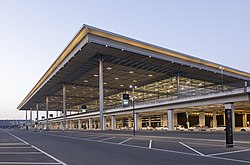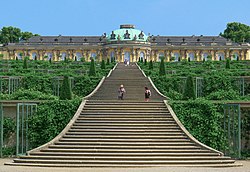- For other places with the same name, see Brandenburg (disambiguation).


Brandenburg (Lower Sorbian: Bramborska; Upper Sorbian: Braniborska) is both a historical region and a modern federal state in Germany. Brandenburg was historically composed of a larger amount of territory now located across the Oder River in western Poland. It is the heart of historic Prussia and surrounds the federal capital Berlin, a separate state. It also borders the states of Saxony, Saxony-Anhalt, Lower Saxony, and Mecklenburg-Western Pomerania, as well as Poland.
Cities
[edit]
- 1 Potsdam — the capital of Brandenburg, bordering Berlin. Widely known for its palaces and landscape as a World Heritage Site.
- 2 Brandenburg an der Havel — oldest town and "cradle" of Brandenburg; ancient cathedral, churches and other medieval buildings.
- 3 Cottbus
- 4 Eisenhüttenstadt — the former "Stalinstadt" was founded in the 1950s as a Soviet-style model town for the metalworkers in the region
- 5 Falkensee near Berlin
- 6 Frankfurt an der Oder — along the Polish border
- 7 Ludwigsfelde
- 8 Mühlberg
- 9 Oranienburg — a quiet suburb housing the remains of one of the few preserved Nazi concentration camps, KZ Sachsenhausen, on German soil. There's also a small palace in the centre of Oranienburg.
- 10 Senftenberg — known for Senftenberger See the former lignite mining and processing town is being transformed as a center of the Lusatian Lake District
- 11 Werder (Havel)
Other destinations
[edit]
Brandenburg is known for its nature.
There is one national park:
- Lower Oder Valley National Park
There are three UNESCO Biosphere Reserves:
- Flusslandschaft Elbe
- Schorfheide-Chorin
- Spreewald.
In addition, there are 11 nature parks:
- Hoher Fläming.
- Nuthe-Nieplitz-Niederung, .
- Westhavelland
- Stechlin-Ruppiner Land
- Uckermärkische Seen
- Barnimer Land
- Märkische Schweiz
- Dahme-Heideseen
- Schlaubetal
- Niederlausitzer Landrücken
- Niederlausitzer Heidelandschaft
The Lusatian Lake District is shared between Brandenburg and neighboring Saxony
Understand
[edit]Brandenburg is composed of two very different parts although the dividing line between them is a bit fuzzy. On the one hand, there is the suburban fringe around Berlin dominated by Potsdam, the biggest city in the state and the state capital but in many ways having been turned into a suburb of Berlin. This area has profited from reunification and Potsdam was the city above 100 000 inhabitants which gained the highest percentage of population in the first two decades of the 21st century. On the other hand, there is the largely rural part of the state that can be described as "everything else" where relatively minor cities like Cottbus, Frankfurt an der Oder or Brandenburg an der Havel serve as regional centers. While those regional centers have turned their fortunes around since post reunification decline, the suburban and rural areas surrounding them struggle economically and are trying to market the wilderness in their surroundings for tourism. The major attraction of Brandenburg is the city of Potsdam with its UNESCO world heritage label. However, besides Potsdam, there are plenty of other attractions that make Brandenburg worth the trip. The gray reminders of 40 years of Communist rule are gone, and now Brandenburg offers lots to discover to the visitor.
Brandenburg was once ridiculed as the Reichsstreusandbüchse (roughly: imperial sandbox) due to its sandy ground and low population density and seen as virtually worthless real estate prior to the ascent of Prussia. The population density is still low (at least by German standards) and this along with its history aided in preserving a lot of the nature and wildlife. In the southeast of Brandenburg, along the border with Saxony, the Lausitz was and still is one of Germany's major open pit coal mining areas. Many of the former pits have been converted into lakes, drawing many (mostly domestic) visitors since GDR times. This region is now known as the Lusatian Lake District
History
[edit]What is now Brandenburg was inhabited by Slavic heathens during much of the early middle ages and there were several attempts to forcibly convert the local inhabitants to Christianity and to incorporate the territory into the Holy Roman Empire. The first attempt in the 10th century ended with a Slavic insurrection and for over a century people were appointed titular rulers to an area not under German possession. This finally changed when "Albert the Bear" of House Ascania conquered parts of the area and negotiated with another Slavic leader to inherit his domains upon his death. The new territorial entity was named "Mark Brandenburg" with "Mark" being an old term for a borderland. The conventional date for the "founding" of the Mark Brandenburg is usually given as 1157. The early modern history of Brandenburg is very closely linked to that of the House of Hohenzollern, a noble family originally from what is now Baden Württemberg which through luck and adroit political maneuvering turned a bunch of worthless sandy territory few people could be bothered to care about into one of the premier empires of continental Europe only to lose it all with the loss of World War I. After having acquired land around Nuremberg (including the castle), the Franconian branch of the Hohenzollern family came into the possession of the "Mark Brandenburg" in 1415 being awarded formal possession of it at the council of Konstanz. The first Hohenzollern to rule Brandenburg was also the last burgrave of Nuremberg, selling his rights to the city after a long tug of war between the city's patricians and the burgrave. His name, of course was Frederick (Friedrich), a name the new branch of the Hohenzollern would wear often as a regnal name.
Tourist information
[edit]- Brandenburg tourism website
Talk
[edit]People in Brandenburg speak German, possibly with the Berlin-Brandenburg dialect which is relatively close to standard German. Low German dialects are sometimes spoken in rural northern Brandenburg, but almost extinct in most areas. Younger people normally do understand English, while English proficiency among the older generation is usually low. Lower Sorbian, which is similar to and to a certain degree mutually intelligible with Polish and Czech, is spoken in a small region in the southeast bordering Saxony and Poland. The number of native speakers is however low and decreasing. All Sorbs are bilingual and speak perfect German, while only few Germans speak Sorbian.
Get in
[edit]By plane
[edit]
Berlin Brandenburg Airport (BER IATA) is the main gateway to the region and the only airport inside the state.
If you are headed for southern Brandenburg the airports of Leipzig/Halle (near Schkeuditz, Saxony (LEJ IATA) and Dresden (DRS IATA) in the neighborhood of Klotzsche, some 15 km or 25 minutes by S-Bahn from the city-center) might be alternatives for you. However, there is generally a wider section of flights to/from Berlin than these airports.
By car
[edit]Since Berlin is located in the middle of Brandenburg, there are highways (Autobahn) to all major directions crossing through Brandenburg. Many places in Brandenburg can be reached by car within one or two hours from the center of Berlin.
The following Autobahns run through Brandenburg: A2, A9, A10, A11, A12, A13, A15. A24 originates in Hamburg and passes through Mecklenburg Vorpommern and goes via Rostock before heading to Berlin.
By public transport
[edit]The railway system is oriented towards Berlin. There are frequent regional trains connecting Berlin with all major cities in Brandenburg. However, it is often difficult to get to smaller places via public transport. There are buses, but travelers should check timetables. The Berlin-Brandenburg-Public-Traffic-Network (VBB) co-ordinates public transport in the region. There is also a consistent tariff system, so travelers can buy a ticket for the entire journey even if they change from the train to buses. The website of the Traffic Network VBB offers information on timetables and tariffs.
By bus
[edit]Get around
[edit]The easiest way to get around is by car. There are several highways (Autobahn), that connect Berlin with different German regions - all leading through Brandenburg. In addition, there are well maintained roads.
Public transport to many rural destinations is poor. There are a few railroad connections within Brandenburg and there are public buses, but travelers should check timetables for connections.
Verkehrsverbund Berlin-Brandenburg (VBB) organizes local public transport in Berlin and Brandenburg.
The Berlin-Brandenburg region has a dense network of regional express and regional rail lines, which is often supplemented by excursion buses at tourist destinations. Most of Brandenburg's tourist destinations can thus be easily reached on an hourly or two-hourly basis. In Brandenburg and Berlin, you can travel comfortably and inexpensively with the Brandenburg-Berlin ticket for €29 with up to 5 people. If you want it even more comfortable, the Brandenburg-Berlin-Ticket is also available for 1st class at €49. The ticket is valid Monday through Friday from 09:00 and on weekends all day until 3 a.m. the following day on all local transportation. Night owls pay only €22 between 18:00 and 06:00 the following day (€42 in 1st class). Single travellers can use the day ticket for the entire VBB network for €21.
Those who enjoy cycling during their vacations can choose between numerous cycling routes in Brandenburg. The flagship is the over 1000-km-long "Tour Brandenburg".
See
[edit]
- Potsdam with its spectacular royal palaces and parks, the Dutch Quarter is a lovely city and a UNESCO World Heritage Site.
- The Spreewald, a unique landscape with hundreds of small irrigation canals, a UNESCO biosphere reserve.
- The wide ranging architecture of Cottbus.
- The medieval windows of the Marienkirche Frankfurt an der Oder.
- Castles and Palaces: There are many smaller and larger rural palaces and castles, some of them are hotels, others museums or private homes; in the Fläming region, there are four medieval castles.
- Historic city centers: many towns in Brandenburg have pretty well kept historic city centers.
Do
[edit]- Hiking
- Cycling
Saddle up and explore the Brandenburg-Barnim countryside - you'll get fit too! Traveling around on two wheels you'll see loads more of the county, and with nine cycle routes to choose from there is no excuse for not getting your bicycle out.
- Inline skating
- 1 Tropical Islands, Wasserburg, Brandenburg. World's largest indoor water park with pools, tubes, slides and a heated spa area. Additional outdoor pools used in summer months. Can get very crowded and expensive.



Eat
[edit]Spreewald-Gurken (pickled cucumbers from the Spreewald-region) were a specialty during GDR times and are again growing in popularity.
Drink
[edit]Club-Cola is one of two big former East German cola brands.
Stay safe
[edit]Brandenburg lacks big cities and therefore also most of their associated crime. However unemployment, low birth rates and general lack of perspective for young people have hit some rural towns hard, and some have lost half their population since 1990. This along with disillusionment after reunification has led some people to radical political ideas and some of them are violent. Caution is advised in some areas, especially at night, and especially for people who look "different" or "foreign".
Violent crime is extremely rare in Germany as a whole, and Brandenburg is no exception. Almost all visitors to Brandenburg never encounter any problems and if you should, the police is usually able and very willing to help you. As the right-wing extremist groups are seen as a huge embarrassment to the state's reputation and also something of a tired cliché in inner-German debate, you should exercise some caution when speaking about that topic, as you might get people upset.
Go next
[edit]- The Baltic Sea Coast (Germany) in Mecklenburg-Western Pomerania
- Poland is right across the Oder/Odra
- Berlin
- The Lausitz in the south is shared with Saxony

